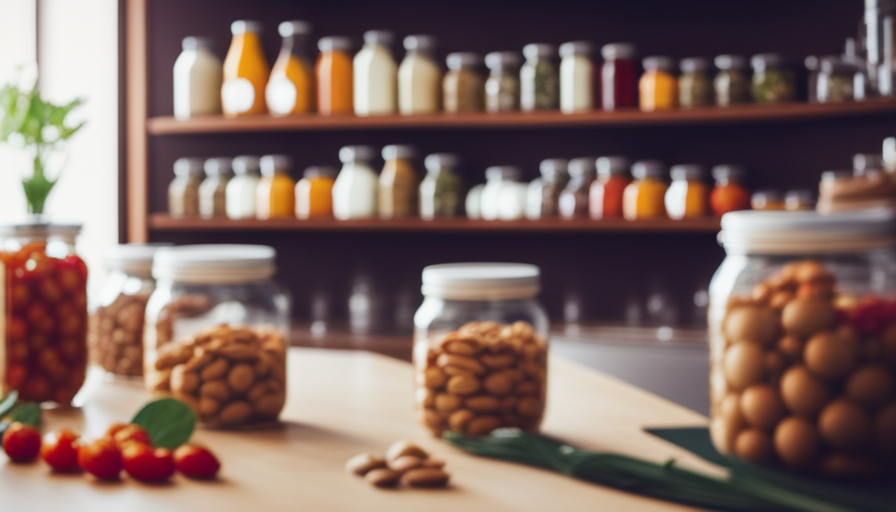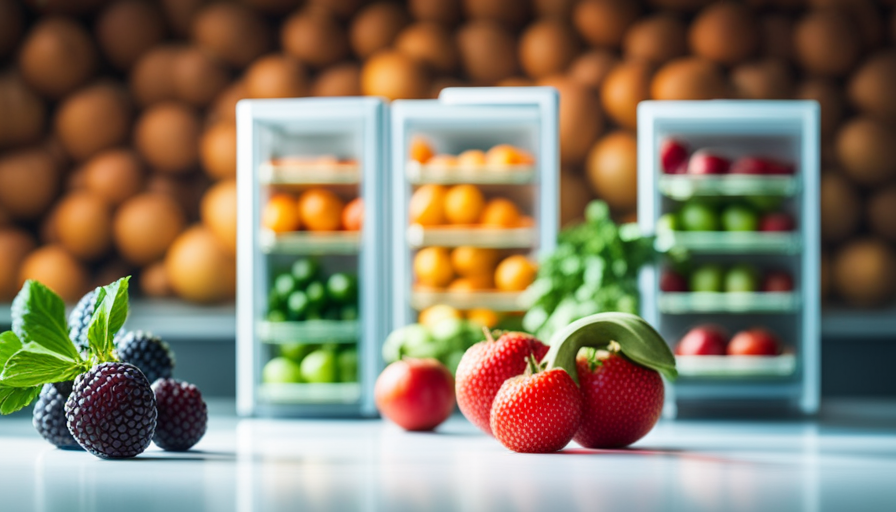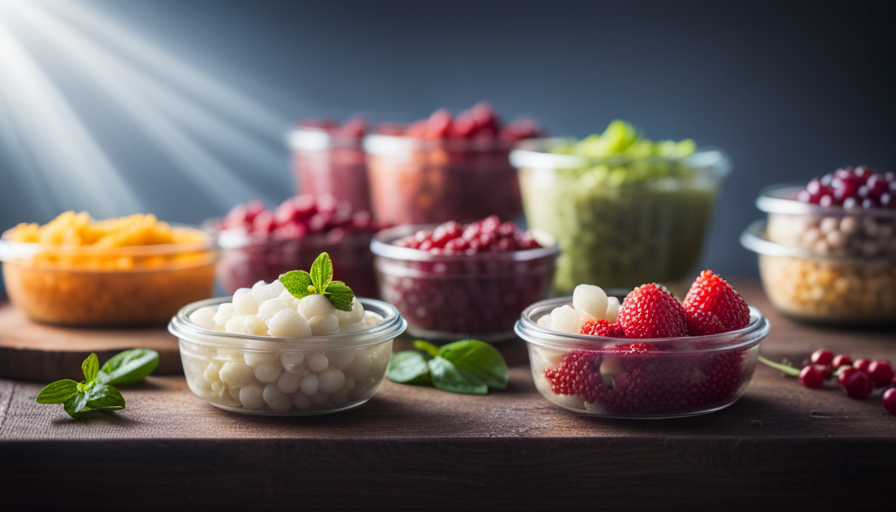Tired of making frequent trips to the supermarket to stock up on fresh fruits, vegetables, meats, and dairy? Annoyed by your groceries spoiling before you even get the chance to enjoy them? Worry no more! In this article, we’ll teach you the best methods for storing large quantities of raw food. This way, you can cut down on your shopping trips and save some cash, all while keeping your food items fresh for an extended period.
Now, you might be thinking, ‘But I don’t have enough storage space!’ Don’t worry, we’ve got you covered. With the right storage containers and techniques, you can maximize the shelf life of your fruits, vegetables, meats, seafood, dairy products, grains, legumes, nuts, and seeds. We’ll even provide you with tips on organizing your pantry and labeling your items for easy access.
So, get ready to become a master of food storage. Say goodbye to waste and hello to a well-stocked kitchen that will keep you cooking delicious meals for weeks to come.
Let’s dive in and discover the secrets to storing raw food in copious amounts.
Key Takeaways
- Use airtight containers to store fruits, vegetables, and canned goods to slow down spoilage and prevent leakage and contamination.
- Store root vegetables in cool, dark, and dry places using breathable containers to maintain freshness.
- Properly marinate meats to enhance flavor.
- Follow proper storage techniques for dairy products, grains, legumes, herbs, and spices to extend shelf life and prevent spoilage.
Proper Storage Containers for Fruits and Vegetables
You should use airtight containers to keep your fruits and vegetables fresh for longer periods of time. Airtight containers create a seal that prevents air from getting in, which slows down the spoilage process.
When it comes to storing fruits and vegetables, there are a few key things to keep in mind. For canned goods, it’s important to choose storage containers that are specifically designed for this purpose. These containers are made with materials that can withstand the acidity of canned foods and prevent any leakage or contamination. Look for containers that are labeled as food-grade and have secure lids to keep your canned goods safe and fresh.
When it comes to root vegetables, such as carrots and potatoes, proper storage is essential to maintain their freshness. Start by removing any excess dirt and moisture from the vegetables. Then, place them in a cool, dark, and dry place, like a cellar or a pantry. Avoid storing them in plastic bags, as this can trap moisture and cause them to rot. Instead, opt for breathable containers, like mesh bags or wooden crates, that allow air circulation and prevent the build-up of moisture.
By using the right storage containers and following these tips, you can ensure that your fruits and vegetables stay fresh and delicious for longer periods of time.
Best Practices for Storing Meats and Seafood
When it comes to keeping meats and seafood fresh, it’s essential to follow some tried-and-true best practices. To ensure the best quality and taste, here are a few tips to keep in mind.
Firstly, when marinating meats, it’s important to use the best methods to enhance flavor. The best way to marinate meats is to place them in a resealable plastic bag and let them sit in the marinade for at least 30 minutes or up to overnight in the refrigerator. This allows the flavors to penetrate the meat, resulting in a more delicious and tender end product.
Secondly, when it comes to seafood, one common issue is freezer burn. To prevent this, it’s crucial to properly wrap the seafood before freezing. Start by patting the seafood dry with paper towels to remove any excess moisture. Then, wrap it tightly in plastic wrap or place it in a freezer-safe container, ensuring there is no air inside. Finally, seal it in a freezer bag for added protection. This will help prevent freezer burn and preserve the quality of the seafood.
By following these best practices, you can ensure that your meats and seafood stay fresh and flavorful. So, marinate your meats with care and prevent freezer burn on your seafood for the best culinary experience.
Extending the Shelf Life of Dairy Products
To make your dairy products last longer, it’s important to properly store them in the refrigerator at temperatures below 40°F. This can extend their shelf life by up to two weeks. Follow these simple tips to ensure the freshness of your dairy items:
-
Wrap your cheese in wax paper or aluminum foil to prevent it from drying out. This’ll help maintain its moisture and flavor for a longer period of time.
-
Store butter in an airtight container or wrap it tightly in plastic wrap to prevent it from absorbing odors from other foods in the fridge. This’ll keep it tasting fresh and delicious.
-
Keep milk and yogurt in their original containers and make sure the lids are tightly sealed. This’ll prevent any contamination and maintain their quality.
-
When storing cream or sour cream, always place them in the coldest part of the refrigerator. This’ll slow down the growth of bacteria and extend their shelf life.
By following these guidelines, you can ensure that your dairy products stay fresh and flavorful for longer. So go ahead and stock up on your favorite cheeses and butter, knowing that they’ll last longer and be ready to enjoy whenever you need them.
Keeping Grains and Legumes Fresh
Storing grains and legumes properly can help maintain their freshness and extend their shelf life. To store dried fruits, it’s important to keep them in a cool, dry place. Moisture can cause the fruits to spoil quickly, so make sure they’re in an airtight container to prevent any moisture from getting in.
Additionally, it’s best to store dried fruits away from direct sunlight, as the UV rays can degrade the quality and flavor.
Preserving the freshness of herbs is a bit different. First, make sure to remove any excess moisture from the herbs by gently patting them dry with a paper towel. Then, store them in airtight containers or resealable bags to prevent any moisture from getting in.
It’s also helpful to store herbs in the refrigerator, as the colder temperature can help retain their freshness for a longer period.
By following these storage tips, you can ensure that your grains, legumes, dried fruits, and herbs stay fresh and flavorful for a longer time. Remember, proper storage is key to maintaining the quality of your food items and reducing waste.
Storing Nuts and Seeds for Longevity
If you want to make your nuts and seeds last, make sure to keep them in a cool, dry place, away from direct sunlight. This is essential to maintain their freshness and extend their longevity.
Nuts and seeds are packed with essential nutrients and provide numerous health benefits. They’re rich in healthy fats, proteins, fiber, vitamins, and minerals. Incorporating them into your diet can improve heart health, boost brain function, and aid in weight management.
To maximize the nutritional benefits of nuts and seeds, it’s important to store them properly. Airtight containers or resealable bags are ideal for keeping them fresh. If you buy them in bulk, consider dividing them into smaller portions to prevent exposure to air and moisture. This will help to maintain their quality and prevent spoilage.
In addition to their nutritional benefits, nuts and seeds are incredibly versatile ingredients that can be used in a variety of creative recipes. They can be added to salads, smoothies, baked goods, and even used as a crunchy topping for yogurt or oatmeal. Roasting them can enhance their flavor and texture, making them a delicious and nutritious snack option.
By following these storage tips and incorporating nuts and seeds into your diet, you can enjoy their nutritional benefits and explore a wide range of creative recipes. So go ahead and stock up on these wholesome goodies and make them a pantry staple!
Preserving Fresh Herbs and Spices
Preserving fresh herbs and spices can add a burst of flavor and aromatic appeal to your culinary creations. When it comes to storing these delicate ingredients, drying techniques are an excellent option. Drying herbs and spices not only extends their shelf life but also concentrates their flavors.
There are various methods you can use to dry herbs and spices. One common technique is air drying, where you simply tie the herbs in small bunches and hang them in a warm, well-ventilated area. Alternatively, you can use a dehydrator or an oven set to a low temperature. Once your herbs and spices are dried, store them in airtight containers in a cool, dark place to maintain their freshness.
Now, what can you do with leftover herbs and spices? Get creative! You can infuse oils or vinegar with herbs to create flavorful dressings or marinades. Another idea is to make herb and spice blends, such as Italian seasoning or curry powder, to enhance the taste of your dishes. Additionally, you can freeze leftover herbs in ice cube trays with a little water or oil, allowing you to easily add them to your recipes later on.
Don’t let those precious herbs and spices go to waste – explore different ways to incorporate them into your cooking and elevate your meals with their vibrant flavors.
Tips for Organizing and Labeling Your Pantry
Now that you’ve learned how to preserve fresh herbs and spices, it’s time to tackle the next step in storing raw food in copious amounts: organizing and labeling your pantry. This crucial step will not only help you keep track of your food inventory, but also make it easier to find what you need when cooking up a storm in the kitchen.
When it comes to organizing small spaces, every inch counts. Utilize every nook and cranny in your pantry by investing in storage solutions that maximize vertical space. Install shelves or use stackable bins to take advantage of the height of your pantry. Additionally, consider using door racks or hanging baskets to store smaller items like spices or snack packets.
To make your pantry even more functional, labeling is key. Create a system that works for you, whether it’s using clear containers with labeled lids or utilizing a label maker for easy identification. This will save you time and frustration when searching for specific ingredients.
To inspire you, here’s a table showcasing some creative storage solutions for pantry items:
| Storage Solution | Description | Benefits |
|---|---|---|
| Over-the-door rack | Hangs on the back of your pantry door | Saves space, easy access to frequently used items |
| Stackable bins | Bins that can be stacked on top of each other | Maximizes vertical space, keeps similar items together |
| Mason jars | Glass jars with airtight lids | Keeps ingredients fresh, visually appealing |
By following these tips for organizing small spaces and incorporating creative storage solutions, your pantry will become a well-organized haven that makes meal prep a breeze.
Freezing Techniques for Long-Term Storage
One effective way to extend the shelf life of your ingredients is by utilizing freezing techniques for long-term storage. Freezing not only helps to preserve the freshness of your raw food, but it also retains their nutritional value.
To maximize the longevity of your frozen ingredients, consider using vacuum sealing. This method involves removing all the air from the packaging, creating a tight seal that prevents freezer burn and preserves the quality of the food. Vacuum-sealed packages can be easily stacked and organized in your freezer, saving valuable space.
Another useful technique for freezing raw food is blanching. Blanching involves briefly immersing the food in boiling water and then immediately transferring it to an ice bath to halt the cooking process. This technique helps to preserve the color, texture, and flavor of the food. Blanching is particularly beneficial for vegetables as it helps to retain their crispness and prevent them from becoming mushy when thawed.
When freezing raw food, it’s important to label each package with the contents and date of freezing. This will help you keep track of what you have in your freezer and ensure that you use the oldest items first.
By utilizing vacuum sealing and blanching techniques, you can effectively store raw food in copious amounts while maintaining their quality and freshness for an extended period of time.
Avoiding Cross-Contamination in the Fridge
To ensure your fridge remains a safe and clean environment for your ingredients, always separate raw meats from other items and use designated containers or bags to prevent cross-contamination. This is essential in avoiding spoilage and preventing bacterial growth.
Here are three key tips to keep in mind:
-
Store raw meats on the bottom shelf: By placing raw meats on the lowest shelf, you prevent any potential drips or leaks from contaminating other foods. This also helps to avoid any accidental contact between raw meats and ready-to-eat items.
-
Use sealed containers or bags: When storing raw meats, it’s important to use sealed containers or bags to keep them separate from other foods. This prevents any juices or bacteria from spreading and causing cross-contamination. Opt for leak-proof containers or double-sealed bags for added protection.
-
Clean and sanitize regularly: Regularly cleaning and sanitizing your fridge is crucial in maintaining a safe storage environment. Wipe down shelves, drawers, and surfaces with a mild detergent or sanitizing solution to remove any potential bacteria. Pay extra attention to areas where raw meats have been stored.
By following these guidelines, you can ensure that your fridge remains a hygienic space for storing raw food and minimize the risk of spoilage or bacterial growth.
Understanding Expiration Dates and Food Safety Guidelines
Make sure you understand expiration dates and follow food safety guidelines to keep your fridge stocked with fresh and delicious ingredients. Understanding food storage guidelines is essential for maximizing freshness and minimizing food waste.
By properly refrigerating your raw food, you can prevent mold and spoilage, reducing the risk of foodborne illnesses.
When it comes to meal prepping and batch cooking, proper food storage is crucial. Use airtight containers to keep your ingredients fresh and prevent cross-contamination. Leftover ingredients can be creatively used in other dishes, reducing waste and saving money.
Temperature control plays a significant role in food safety. Set your fridge temperature below 40°F (4°C) to ensure that perishable items stay fresh for longer. Regularly check the temperature using a fridge thermometer to maintain a safe environment for your food.
Packaging also affects food storage. Opt for containers that are specifically designed for storing raw food. They should be leak-proof and resistant to moisture and odors to extend the shelf life of your ingredients.
By understanding expiration dates and following food safety guidelines, you can ensure that your raw food stays fresh and safe to eat. Proper refrigeration, minimizing food waste, and creative uses for leftovers will help you maintain a well-stocked fridge with delicious ingredients at all times.
Frequently Asked Questions
How do I prevent my fruits and vegetables from getting squished or bruised in the storage containers?
To prevent your fruits and vegetables from getting squished or bruised in storage containers, there are several preventive measures and proper storage techniques you can follow.
Firstly, choose containers that provide enough space for your produce to breathe and stay separate. Additionally, consider using cushioning materials like paper towels or bubble wrap to protect delicate items.
Arrange your fruits and vegetables carefully, avoiding stacking or overcrowding. Finally, handle them gently when placing them in or taking them out of the containers.
Can I use regular plastic bags to store meats and seafood, or do I need special containers?
Regular plastic bags can be convenient for storing meats and seafood, but there are pros and cons compared to vacuum sealing. Vacuum sealing removes all air, preventing freezer burn and extending shelf life. However, regular packaging is more accessible and requires less equipment.
To store raw meat and seafood in the freezer, follow best practices like wrapping tightly in plastic wrap, placing in airtight containers, and labeling with the date. This ensures freshness and prevents cross-contamination.
What are some ways to prevent dairy products from spoiling quickly?
To prevent dairy products from spoiling quickly, there are several innovative dairy storage solutions you can try. First, make sure to keep your fridge temperature consistently below 40°F (4°C).
Additionally, store dairy products in airtight containers to minimize exposure to air and bacteria. Consider using specialized dairy storage containers with built-in temperature controls.
Another option is vacuum-sealing dairy products to extend their shelf life.
Lastly, regularly check expiration dates and consume dairy products before they spoil.
How can I keep grains and legumes from getting infested with pests?
To prevent pantry pests and store grains and legumes without pests, follow these steps:
- Start by inspecting the packaging for any signs of infestation before purchasing.
- Transfer the grains and legumes into airtight containers to prevent pests from entering.
- Keep the pantry clean and organized, regularly removing any spilled food or debris.
- Use pest-resistant packaging or add bay leaves, cloves, or peppermint sachets to repel pests.
- Finally, regularly check for signs of infestation and discard any infested items immediately.
Is it necessary to vacuum-seal nuts and seeds for long-term storage, or are there other methods that can be used?
Do you really need to vacuum-seal nuts and seeds for long-term storage? Fortunately, there are alternative methods that can be just as effective.
Using airtight containers or freezing can help preserve the freshness and quality of nuts and seeds for extended periods. While vacuum sealing can offer longer shelf life, it may also impact the nutritional value and taste of these ingredients.
Consider the trade-off and choose the method that best suits your needs.
What Are the Best Practices for Storing Raw Food in Large Quantities?
When it comes to storing raw food in a restaurant, it’s important to follow best practices to maintain freshness and quality. Store raw food restaurant in airtight containers to prevent cross-contamination and keep it at the proper temperature to avoid spoilage. Regularly rotating stock ensures that older items are used first.
Conclusion
In conclusion, by following proper storage techniques and utilizing the right containers, you can store raw food in copious amounts while maintaining its freshness and safety.
Although some may argue that it takes too much time and effort to organize and label the pantry, the benefits far outweigh the initial investment. By keeping your pantry well-organized, you can easily locate and utilize your stored food, saving you time and money in the long run.
So, don’t let the fear of organization deter you from enjoying the convenience and longevity of stored raw food.










